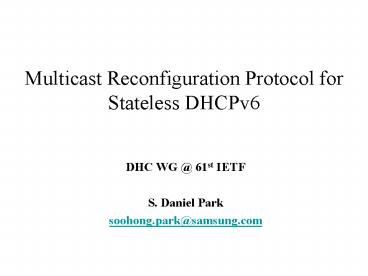Multicast Reconfiguration Protocol for Stateless DHCPv6 - PowerPoint PPT Presentation
Title:
Multicast Reconfiguration Protocol for Stateless DHCPv6
Description:
Multicast Reconfiguration Protocol for Stateless DHCPv6 DHC WG _at_ 61st IETF S. Daniel Park soohong.park_at_samsung.com Background It requires the DHCPv6 server to send ... – PowerPoint PPT presentation
Number of Views:4
Avg rating:3.0/5.0
Title: Multicast Reconfiguration Protocol for Stateless DHCPv6
1
Multicast Reconfiguration Protocol for Stateless
DHCPv6
- DHC WG _at_ 61st IETF
- S. Daniel Park
- soohong.park_at_samsung.com
2
Background
- It requires the DHCPv6 server to send unicast
Reconfigure messages to the individual nodes'
addresses and trigger them to initiate
Renew/Reply or Information-Request/Reply by which
they can obtain the updated configuration
information. - This is not possible in RFC3736 as the server
doesn't remember the state of the client,
including the address by which the client can be
reached.
3
Overview
- Make use of the RAs to notify the clients in the
renumbered link about the configuration change - A new option was defined in ICMPv6
- Server initiates the relay to trigger RAs in the
clients link which will in-turn trigger the
clients to contact the server to obtain the
updated information - DHCPv6 policies along with M and O flag of RA are
newly defined in IPv6 WG
4
Intention
- This protocol is used to reconfigure stateless
DHCPv6 domain in conjunction with RA - This protocol should take into account of how M
and O flag of RA are used and defined - Reorganizing it along with a new MO draft, if
this protocol is of interest (WG Item)
5
Server Behavior
- Server sends the Relay-repl message to the Relay
attached to the clients link with peer-addr as
and the encapsulated reconfigure message will
have an unique xid - It may include Interface-id option
- The server will retransmit the relay-repl message
till it receives DHCP Reply from the relay
6
Relay Client Behavior
- When the relay receives a Relay-repl message
which identifies one of its link and has an
unspecified address in peer-addr field, it does - Triggers the router to send RA with an option
which carries the xid copied from encapsulated
reconfigure message from the server and makes the
clients to contact the server to obtain the
updated information - May maintain xid cache when a new option is used
- There is no change in the clients behavior
7
DHCPv6 Policy (1/2)
- 6.2 M-Policy
- o Policy 1
- The host should invoke Host Configuration
Behaviour for address autoconfiguration (along
with - other configuration information) regardless of
the content of received Router Advertisement - messages or the existence of Router Advertisement
messages. - o Policy 2
- The host should invoke Host Configuration
Behaviour for address autoconfiguration (along
with - other configuration information) if and only if
it sees a Router Advertisement changing the
M-Flag - from FALSE to TRUE.
- o Policy 3
- The host should not invoke Host Configuration
Behaviour for address autoconfiguration (along - with other Configuration information) regardless
of the content of received Router Advertisement - messages or the existence of Router Advertisement
messages.
8
DHCPv6 Policy (2/2)
- 6.3 O-Policy
- o Policy 1
- The host should invoke Information Configuration
Behaviour for getting other configuration
information - regardless of the content of received Router
Advertisement messages or the existence of Router - Advertisement messages.
- o Policy 2
- The host should invoke Information Configuration
Behaviour for getting other configuration
information - if and only if it sees a Router Advertisement
changing the O-Flag from FALSE to TRUE. - o Policy 3
- The host should not invoke Information
Configuration Behaviour for getting other
configuration - information regardless of the content of received
Router Advertisement messages or the existence of - Router Advertisement messages.
9
Assumption
- The Relay resides in the same machine as router
- Even it doesnt coexist, the relay should be able
to trigger RAs but with default router flag
disabled - This protocol doesnt work in the absence of IPv6
router in the link
10
Advantages
- This mechanism can be further extended to be used
in stateful DHCPv6, thus it can increase the
performance - This can override the need of RAs sending service
parameters/addresses
11
Security considerations
- SEND can be used to secure the RA
- Server Relay communication will be secured by
IPSec as per RFC 3315
12
Related Work
- The related work on this draft can be found in
- http//www.ietf.org/internet-drafts/draft-ietf-dhc
-stateless-dhcpv6-renumbering-02.txt - http//ietf.org/internet-drafts/draft-vijay-dhc-dh
cpv6-mcast-reconf-00.txt - M and O flag document was officially accepted as
IPv6 WG item - http//www.watersprings.org/pub/id/draft-daniel-ip
v6-ra-mo-flags-01.txt
13
Concluding remarks
- Reorganizing this work along with M and O flag
draft, if WG needs this protocol - Suggesting a reconfiguration scheme in RFC3736
without options - O-Policy 1 or 2 triggering a client to do a
reconfiguration through RA - O-Policy 3 Not possible
- Go ahead ?































